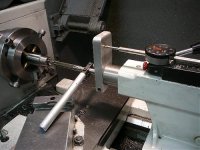M
mpatti
Guest
I noticed that they sell a Morse Taper holder that fits on a quick change tool holder. I have a floating reamer pusher that could fit in this. Is there any benefit to using the Tool post instead of the Tailstock to Ream a chamber.
I was thinking that it would be easier to use a dial indicator on the Carraige of my lathe but be a bit of a pain to center each time. With the floating pusher, close should be good enough though. Anyone ever chamber this way or is it just a bad idea???
I was thinking that it would be easier to use a dial indicator on the Carraige of my lathe but be a bit of a pain to center each time. With the floating pusher, close should be good enough though. Anyone ever chamber this way or is it just a bad idea???


